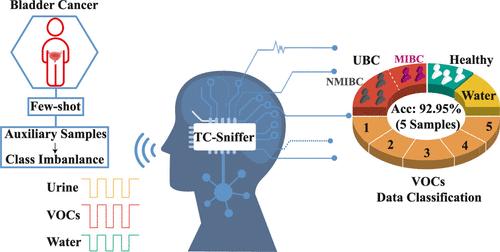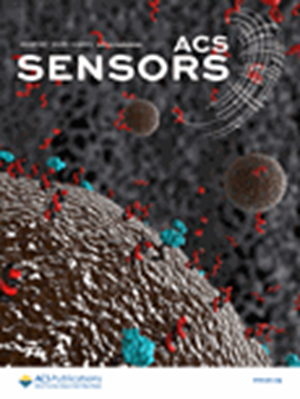TC-Sniffer:利用辅助挥发性有机化合物的变压器-CNN Bibranch 框架,通过电子鼻实现 UBC 的快速诊断
IF 8.2
1区 化学
Q1 CHEMISTRY, ANALYTICAL
引用次数: 0
摘要
利用带有模式识别算法的电子鼻(e-noses)为早期检测膀胱癌(UBC)提供了一种前景广阔的无创方法。然而,有限的临床样本往往会阻碍现有的人工智能(AI)辅助诊断。本文提出的 TC-Sniffer 是一种用于 UBC 少量诊断的新型支链框架,它利用容易获得的 UBC 相关挥发性有机成分(VOC)作为辅助分类类别。这些挥发性有机成分是 UBC 的生物标记物,有助于模型学习更多 UBC 特定特征,减少小样本情况下的过拟合,并反映临床样本的不平衡分布。TC-Sniffer 采用基于强度的增强技术来解决小样本量问题,并采用焦点丢失技术来减轻因辅助 VOC 造成的类别不平衡而导致的模型偏差。该架构结合了变压器和时序卷积神经网络,以捕捉长程和短程依赖关系,从而实现全面的表征学习。此外,特征级约束进一步加强了对每个类别的独特特征的学习。使用从定制传感器阵列收集的电子鼻数据进行的实验结果表明,TC-Sniffer 显著超越了现有方法,仅用五个 UBC 训练样本就达到了 92.95% 的平均准确率。此外,细粒度分类结果表明,该模型可以区分非肌肉浸润性膀胱癌(NMIBC)和肌肉浸润性膀胱癌(MIBC),这两种癌症都是 UBC 的亚型。TC-Sniffer的卓越性能突显了它在具有挑战性的临床环境中及时准确诊断癌症的潜力。本文章由计算机程序翻译,如有差异,请以英文原文为准。

TC-Sniffer: A Transformer-CNN Bibranch Framework Leveraging Auxiliary VOCs for Few-Shot UBC Diagnosis via Electronic Noses
Utilizing electronic noses (e-noses) with pattern recognition algorithms offers a promising noninvasive method for the early detection of urinary bladder cancer (UBC). However, limited clinical samples often hinder existing artificial intelligence (AI)-assisted diagnosis. This paper proposes TC-Sniffer, a novel bibranch framework for few-shot UBC diagnosis, leveraging easily obtainable UBC-related volatile organic components (VOCs) as auxiliary classification categories. These VOCs are biomarkers of UBC, helping the model learn more UBC-specific features, reducing overfitting in small sample scenarios, and reflecting the imbalanced distribution of clinical samples. TC-Sniffer employs intensity-based augmentation to address small sample size issues and focal loss to alleviate model bias due to the class imbalance caused by auxiliary VOCs. The architecture combines transformers and temporal convolutional neural networks to capture long- and short-range dependencies, achieving comprehensive representation learning. Additionally, feature-level constraints further enhance the learning of distinctive features for each class. Experimental results using e-nose data collected from a custom-designed sensor array show that TC-Sniffer significantly surpasses existing approaches, achieving a mean accuracy of 92.95% with only five UBC training samples. Moreover, the fine-grained classification results show that the model can distinguish between nonmuscle-invasive bladder cancer (NMIBC) and muscle-invasive bladder cancer (MIBC), both of which are subtypes of UBC. The superior performance of TC-Sniffer highlights its potential for timely and accurate cancer diagnosis in challenging clinical settings.
求助全文
通过发布文献求助,成功后即可免费获取论文全文。
去求助
来源期刊

ACS Sensors
Chemical Engineering-Bioengineering
CiteScore
14.50
自引率
3.40%
发文量
372
期刊介绍:
ACS Sensors is a peer-reviewed research journal that focuses on the dissemination of new and original knowledge in the field of sensor science, particularly those that selectively sense chemical or biological species or processes. The journal covers a broad range of topics, including but not limited to biosensors, chemical sensors, gas sensors, intracellular sensors, single molecule sensors, cell chips, and microfluidic devices. It aims to publish articles that address conceptual advances in sensing technology applicable to various types of analytes or application papers that report on the use of existing sensing concepts in new ways or for new analytes.
 求助内容:
求助内容: 应助结果提醒方式:
应助结果提醒方式:


